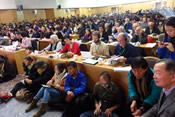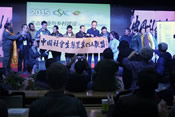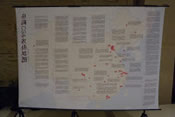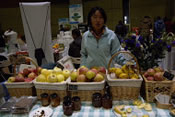
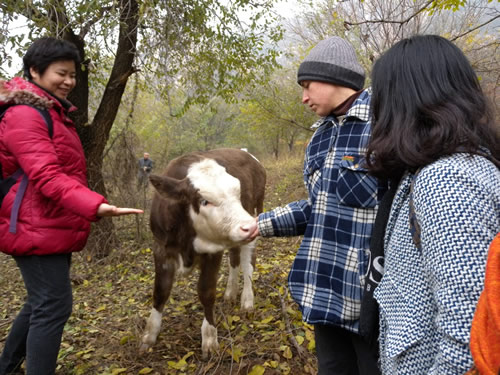 |
| On November 18, we visited the Phoenix Hills Commune in Beijing, and by chance took part in a practical class on biodynamics at its school, Gengdu College, which was established in 2015. (Core Kang) |
By Core Kang (Planning Department, Taiwan Homemakers Union Consumers Co-op)
|
Editor’s note: The 6th International CSA Conference and the 7th China CSA Conference were held in Beijing on November 19-22, 2015. The conferences were hosted by Tsinghua University, Rural Reconstruction Centre of Renmin University of China and the International Network for Community Supported Agriculture (URGENCI). Pioneers and scholars in ecological agriculture or CSA from over 20 countries, including mainland China, were invited to discuss various issues, including food safety, the sustainable development of rural areas, farmers and agriculture (san nong, or the three rural issues of China), agro-tourism, rural reconstruction and Participatory Guarantee System for CSA, running CSA projects, rebuilding urban-rural relationship, and how to achieve equality between citizens and farmers. Community Supported Agriculture (CSA) is a system of agricultural production that advocates “conserving resources and being environmentally–friendly” in production, and aims to bridge the distribution gap between human beings and food and between consumers and producers. By subscribing to the harvest of farmers on a long term basis, consumers support the livelihood of small-scale farmers and share their risks as well as their harvest. In this way, mutual trust can be nurtured between farmers and consumers, and a friendly and mutually beneficial relationship can be developed between urban and rural areas. The CSA movement first became popular in Europe and Japan in the 1960s. It has been on the rise in recent years in mainland China, Hong Kong and Taiwan, the development in the mainland and in Taiwan being particularly rapid. PCD has always promoted the development of CSA. We have therefore funded our partners in mainland China and in Taiwan to take part in the important conferences in Beijing. Core Kang, the representative of Taiwan Homemakers Union Consumers Co-op was one of the participants we supported. In this article, she explains succinctly her thoughts on the gap between urban and rural areas—a critical issue of CSA, and goes on to reflect on the deeper meaning of this issue. |
On November 17, 2015, I flew to Beijing, China from Taoyuan in Taiwan. The trip lasted only three and a half hours. If I were taking a slow train departing from Taipei, I would be arriving in Changhua in the western part of Taiwan. I remembered that I had been in Beijing for over ten days a decade before in August 2005. In those days, to go from Beijing Film Academy to the bustling Wangfujing Street, one took a taxi because it was the most convenient way. Even the locals would tell you to take a taxi. I remember looking out through the clear windows and seeing many bicycles and pedestrians, pushing and shuffling along, and with only the thin exterior of the car separating us, I felt as though I was brushing shoulders with them all. Many old people in the streets wore the traditional Neiliansheng cloth shoes with a thousand-layer sole. Black cloth shoes with their white soles on the pavement conjure up a vivid picture of old Beijing life. The landscape is now densely dotted with subways, which changes the way the people of the city connect with each other, as well as the way travellers find their way around the city. Apart from the damp, grey colour of the sky, the only thing that reminded me of Beijing before the Olympic Games was occasionally hearing a deep, northern-accented voice.
Challenges posed by the distance between urban and rural China
Before I left for the Shunyi District of Beijing for the 6th International CSA Conference and the 7th China CSA Conference, I was rethinking distance, something which soon became the focus of my trip: How does a city support a remote village? If Taipei was the starting point, the furthest rural village such as Fangliao in Pingtung and Peinang in Taitung etc. could be reached in a day. I chatted with Tang Liang, a young man returning from the city to his Jintang County in Chengdu, Sichuan, about the long distances involved in transporting farm products to the market. The vans, which are usually not equipped with refrigerators, are used to transport more durable crops, such as grains, roots and tubers. For example, a food mile of 1,700 km normally takes at least two days, not including the time for packaging at distribution centres. One can of course send them by air, but it is too costly for small-scale farmers, and consumers at the other end cannot afford to pay more either.
Geographic advantages help build Taiwan’s local food network
On the evening I checked in at the venue of the CSA conference, an exchange programme was held at Community Market, a real “market” run by Beijing Organic Farmers Market. On behalf of Taiwan Homemakers Union Consumers Co-op, I talked about “the revolution of the vegetable basket”. I then talked about the importance of self-awareness—to be aware that one consumes for the sake of living and not for the sake of consumption. In the 1980s, as environmental and food safety issues were drawing public attention in Taiwan, a group of mothers, in a bid to regain control over food that their families consumed, took to the streets to voice their concern as consumers, and visited the farms.. In 1993, over a hundred families launched a collective purchase movement, and ordered rice and grapes directly from the farmers. In 1995, the scheme of “A Basket of Vegetables” was launched in collaboration with farmers of Sanchih District in Taipei. The idea of planned production/planned consumption aims to achieve ideals rooted in everyday life—to improve local agriculture, to support small-scale farmers, to cultivate healthy non-toxic vegetables and to control the level of nitrate in vegetables. In terms of community economy and food miles, Taiwan’s CSA appears more like an independent local food network in comparison with the distance between urban and rural in China.
The critical issue: How far is everyday life from agriculture?
Looking at this seemingly small aspect of the issue, we may ask: from what distance can a city support its rural village? What we see now is consumers can help to slow down the disappearance of rural areas, but as I reflect again on the distance between our everyday life and agriculture, I still want to return to the issue of self-awareness. We should be aware of ourselves not just as consumers, but each as different people with different roles in a living culture and environment. This is what is critical for the sustainability of rural areas. I remember the words of Qu Keli, a young returnee from Kang County in Longnan, Gansu Province: “How could I sustain my love for our home village? This is something that I keep thinking about. I may love my home village, but what does it mean for other people? Why must you love your home village? What is the way out for someone who loves one’s home village?” There has been much hard work behind these questions. Qu and his schoolmates started off organising the Wangping Cultural Society and later set up the Wangping Society for the Love of the Home Village. Among other things, they published an encyclopedia on Wangping and organised a series of activities and farmers’ galas. What moved me in particular was the fact that Qu had been motivated initially by a desire to rediscover the taste of and the feelings about his home village in his memory. This is what ultimately motivates one to return to everyday life.
I want to sincerely thank Chang Cheng-yang, Director of Chi Mei Community College in Taiwan and PCD for inviting me to take part in the conference. I had the opportunity to witness the aspirations and the source of life of a group of people who truly live off the land. The countryside is the breadbasket of our lives. We only have to look back and slow down to be a part of it. We can see the face of a life in which fatigue and exhaustion might be inevitable, yet it is something we can share and connect with jointly, as we bring agriculture and everyday life closer through self-awareness.


